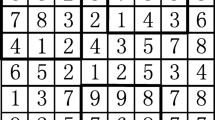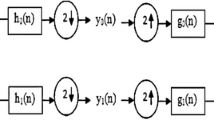Abstract
Image noises are usually generated in the processes of collection, transmission, and storage of images, while some noises, named internal noises, come from the image itself. The noises decrease image visual effect and quality. Thus, it is very important to remove the noises from the images. In this paper, we propose a one-dimensional surface blur algorithm based on wavelet transform and bilateral filtering for image internal noise elimination and detail preservation. In our algorithm, we first transform the two-dimensional image into one-dimensional signal vectors by merging the pixels in each row and column of the image. Then, we decompose each of the vectors into two parts: the low-frequency and high-frequency components with a discrete wavelet transform. We further perform the bilateral filtering and a local variance-based thresholding method on the two components to smooth and denoise signals, respectively. Finally, we evaluate our algorithm’s performance in a group of face images. The experimental results show that our algorithm achieved better performance on image denoising and detail preservation than a set of traditional smoothing methods and the state-of-the-art. Our algorithm is a simple, effective, and easy-to-implement method, and it is suitable for image smoothing to improve the image’s visual effect and quality.










Similar content being viewed by others
References
Black M, Sapiro G, Marimont D, et al. (1998) Robust anisotropic diffusion. IEEE Trans Image Process 7(3):421–432
Buades A, Coll B, Morel J (2005) A non-local algorithm for image denoising. In: Proceedings of the IEEE computer society conference on computer vision and pattern recognition. IEEE, pp 60–65
Chaudhury K, Dabhade S (2016) Fast and provably accurate bilateral filtering. IEEE Trans Image Process 25(6):2519–2528
Chaudhury K, Sage D, Unser M (2011) Fast O(1) bilateral filtering using trigonometric range kernels. IEEE Trans Image Process 20(12):3376–3382
Chen Y, Wang J, Chen X, Zhu M, Yang K, Wang Z, Xia R (2019) Single-image super-resolution algorithm based on structural self-similarity and deformation block features. IEEE Access 7:58791–58801
Chen Y, Liu L, Tao J, et al. (2020) The improved image inpainting algorithm via encoder and similarity constraint. Vis Comput: 1–15. https://doi.org/10.1007/s00371-020-01932-3
Chen Y, Tao J, Liu L, et al. (2020) Research of improving semantic image segmentation based on a feature fusion model. Journal of Ambient Intelligence and Humanized Computing:1–13 https://doi.org/10.1007/s12652-020-02066-z
Durand F, Dorsey J (2002) Fast bilateral filtering for the display of high-dynamic-range images. ACM Trans Graph 21(3):257–266
Hou Y, Xu J, Liu M, et al. (2020) NLH: a blind pixel-level non-local method for real-world image denoising. IEEE Trans Image Process 29:5121–5135
Ichikawa K, Kawashima H, Shimada M, Adachi T, Takata T (2019) A three-dimensional cross-directional bilateral filter for edge-preserving noise reduction of low-dose computed tomography images. Comput Biol Med 111:1–9
Li F, Fergus R, Perona P (2004) Learning generative visual models from few training examples: an incremental Bayesian approach tested on 101 object categories. In: Proceedings of international conference on computer vision & pattern recognition workshop, pp 178–186
Li F, Ming J, Xia T, et al. (2017) The research of the seismic image enhancement using the diffusion filtering with the continuity factor. In: Proceedings of the 79th EAGE conference and exhibition, vol 1, pp 1–5
Liu J, Lei Y (2010) Application of wavelet analysis in ultrasonic testing signal processing. Electric Welding Machine 40(7):77–80
Liu W, Zhang P, Huang X, et al. (2020) Real-time image smoothing via iterative least squares. ACM Trans Graph 39(3):1–24
Luo Y, Qin J, Xiang X, et al. (2020) Coverless real-time image information hiding based on image block matching and dense convolutional network. J Real-Time Image Proc 17(1):125–135
Perona P, Malik J (1990) Scale-space and edge detection using anisotropic diffusion. IEEE Transactions on Pattern Analysis and Machine Intelligence 12(7):629–639
Pham T, Vliet L (2005) Separable bilateral filtering for fast video preprocessing. In: Proceedings of the Conference on Multimedia & Expo, pp 1–4
Singh K, Sharma B, Singh J, Srivastava G, Cheng X (2020) Local statistics-based speckle reducing bilateral filter for medical ultrasound images. Mob Netw Appl 25(12):1–23
Tian C, Xu Y, Zuo W (2020) Image denoising using deep CNN with batch renormalization. Neural Netw 121:461–473
Tomasi C, Manduchi R (1998) Bilateral filtering for gray and color images. In: Proceedings of the conference on computer vision. pp 839–846
Turkowski K (1990) Filters for common resampling-tasks. Graphics Gems I:147–165. https://doi.org/10.1016/B978-0-08-050753-8.50042-5
Valsesia D, Fracastoro G, Magli E (2020) Deep graph-convolutional image denoising. IEEE Trans Image Process 29:8226–8237
Xu J, Zhang L, Zhang D (2018) A trilateral weighted sparse coding scheme for real-world image denoising. In: Proceedings of the European conference on computer vision (ECCV), pp 20–36
Yao S (2006) One-dimensional signal denoising based on wavelet analysis. China Science and Technology Information 16:286–288
Yu S, Park B, Jeong J (2019) Deep iterative down-up CNN for image denoising. In: Proceedings of the IEEE conference on computer vision and pattern recognition workshops, pp 1–9
Zhang J, Wang W, Lu C, et al. (2020) Lightweight deep network for traffic sign classification. Ann Telecommun 75(7):369–379
Zhou F (2013) Study on the multi-focus image processing technology based on rough set and neural netword. Dissertation, Beijing Institute of Graphic Communication
Acknowledgements
The work was supported by grants from the National Natural Science Foundation of China [No.62007028, 41631175, 61702068], the Key Project of Ministry of Education for the 13th 5-years Plan of National Education Science of China [No.DCA170302], and the Priority Academic Program Development of Jiangsu Higher Education Institutions [No.1643320H111].
Author information
Authors and Affiliations
Corresponding author
Additional information
Publisher’s note
Springer Nature remains neutral with regard to jurisdictional claims in published maps and institutional affiliations.
Rights and permissions
About this article
Cite this article
Liu, C., Pang, M. One-dimensional image surface blur algorithm based on wavelet transform and bilateral filtering. Multimed Tools Appl 80, 28697–28711 (2021). https://doi.org/10.1007/s11042-021-10754-x
Received:
Revised:
Accepted:
Published:
Issue Date:
DOI: https://doi.org/10.1007/s11042-021-10754-x




